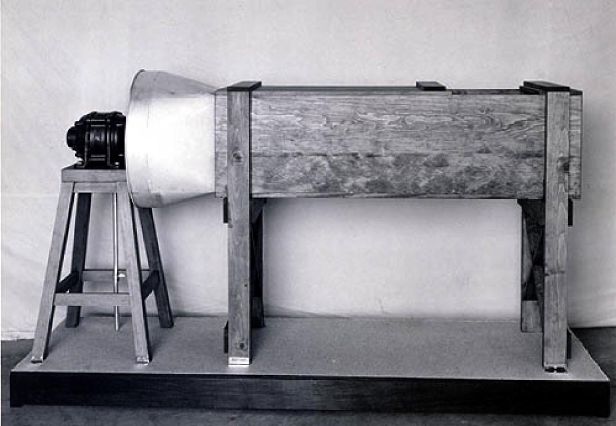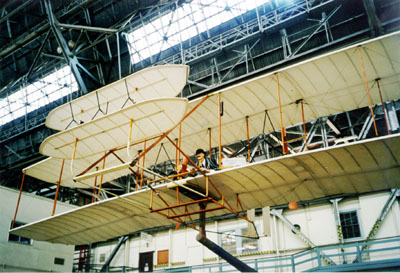

My brother Orville and I built a rectangle-shaped open-ended wind tunnel out of a wooden box. It was 16 inches wide by 16 inches tall by 6 feet long. Inside of it we placed an aerodynamic measuring device made from an old hacksaw blade and bicycle-spoke wire. We directed the air current from an old fan in the back shop room into the opening of the wooden box. In fact, we sometimes referred to one of the two open ends of the wind tunnel as the "goesinta" and the other end as the "goesouta." An old one-cylinder gasoline engine (that also turned other tools in the shop, such as our lathe) supplied the power to turn the fan. This was because there was no electricity in our shop. In fact, even the lights were gas lights.
It took us about a month of experimenting with the wind tunnel we had built to learn how to use it effectively. Eventually we learned how to operate it so that it gave us results that varied less than one-tenth of a degree. Occasionally I had to yell at my brother to keep him from moving even just a little in the room because it would disturb the air flow and destroy the accuracy of the test.
Over a two month period we tested more than two hundred models of different types of wings. All of the models were three to nine inches long. Altogether we measured monoplane wing designs (airplanes with one wing), biplanes, triplanes and even an aircraft design with one wing behind the other like Professor Langley proposed. Professor Langley was the director of the Smithsonian Museum at the time and also trying to invent the first airplane. On each little aircraft wing design we tested we located the center of pressure and made measurements for lift and drift. We also measured the lift produced by wings of different "aspect ratios." An aspect ratio is the ratio or comparison of how long a wing is left to right (the wing span) compared to the length from the front to the back of the wing (the wing chord). Sometimes we got results that were just hard to believe, especially when compared to the earlier aerodynamic lift numbers supplied by the German Lillienthal. His numbers were being used by most of the early aviation inventors and they proved to be full of errors. Lillienthal didn't use a wind tunnel like Orville and I did to obtain and test our data.
We finally stopped our wind tunnel experiments just before Christmas, 1901. We really concluded them rather reluctantly because we had a bicycle business to run and a lot of work to do for that as well.
It is difficult to underestimate the value of that very laborious work we did over that homemade wind tunnel. It was, in fact, the first wind tunnel in which small models of wings were tested and their lifting properties accurately noted. From all the data that Orville and I accumulated into tables, an accurate and reliable wing could finally be built. Even modern wind tunnel data with the most sophisticated equipment varies comparatively little from what we first discovered. In fact, the accurate wind tunnel data we developed was so important, it is doubtful if anyone would have ever developed a flyable wing without first developing this data. Sometimes the non-glamorous lab work is absolutely crucial to the success of a project.
In any case, as famous as we became for our "Flyer" and its system of control, it all would never have happened if we had not developed our own wind tunnel and derived our own correct aerodynamic data.
- Wilbur Wright
The reasoned approach the Wright Brothers took to solving the problem of flight and the diligence with which they pursued their goal is not generally appreciated. The science of aerodynamics, the physics as described by mathematical equations, had been codified centuries earlier by men such as Newton, Bernoulli, Euler, Navier, and Stokes; men who's names are attached to some of the fundamental equations of fluid dynamics. However, not until the Wright Brothers had anyone successfully conquered the engineering - turning the science into an airplane of practical use. Beginning in 1899, Wilbur and Orville executed a research and development program that resulted in not just the 1903 Flyer, but in the first truly practical heavier-than-air flying machine in 1905.

|
The Wrights gained a thorough appreciation of the state of the art (alluded to above in reference to the work of Lillienthal and Langley) through correspondence with some of the well known aviation researchers of their day and from the writings of others, and used this knowledge as a starting point for their own work. However, the Wrights were not blinded by reputation; when the results of their own experiments did not match the predictions based upon existing theory and published data, the two brothers devised means to obtain the data they required via experiments with full-scale kites, both manned and un-manned, and with sub-scale models tested in a wind tunnel of their own design.
With respect to the wind tunnel, it is interesting to re-read the fifth paragraph above. Wilbur does not claim to have invented the first wind tunnel, Edme Mariotte published a description of a wind tunnel in "Traite du mouvement des eaux" in 1686, and Wenham and Browning constructed one in the 1870's. Rather, theirs was the first tunnel where accurate sub-scale aerodynamic data was obtained and systematically recorded for later application to the design of the full-scale Flyer. To this day the process is essentially the same - engineers first design according to theory then test their designs sub-scale in the wind tunnel. Yet there is one significant difference between modern day wind tunnel tests and the Wright Brothers work. The Wrights relied primarily on parametric data of components, while most modern wind tunnel tests are conducted on models which are as accurate a representation of the aircraft design as limitations of the tunnel and of the model size permit.
It was to reconcile the two different approaches, to bring the work of the
Wright Brothers up-to-date so to speak, that the AIAA Wright Flyer Project began
what became a series of three wind tunnel tests: two sub-scale and one
full-scale. This is not to imply in any way that the Wright Brothers were
incorrect in their approach. They obtained sufficient data to design and build
their airplanes, and did so quickly, cheaply, and successfully. Yet to fully
appreciate their accomplishments from a modern perspective, the Project decided
that a modern wind tunnel test program was a worthy and valuable goal.
...Previous Page |
Next Page... |
Back to the Title Page |
Give Us Feedback! |
Copyright © 1999-2001, AIAA Wright Flyer Project, all rights reserved.